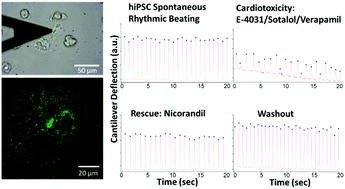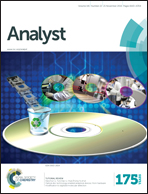Evaluation of drug-mediated arrhythmic changes in spontaneous beating cardiomyocytes by AFM†
Abstract
Arrhythmia caused by drug-induced cardiotoxicity is among the leading reasons for late-stage drug attrition and is therefore a core subject in safety testing of new compounds. Alternative methods such as surface and interface characterization approaches for assessing the drug-mediated cardiotoxicity should be promoted, in order to reduce, refine and replace the use of laboratory animals. Here, we investigate the possibility of using known human Ether-à-go-go-Related Gene (hERG) channel blockers to induce irregular beating patterns in the mouse and human induced pluripotent stem cell-derived (miPSC and hiPSC) cardiomyocyte (CM) model systems. An AFM-based approach was developed to precisely monitor the beating interval and rate of cardiomyocytes. Verification was implemented using three individual cardiovascular compounds to validate the potential application of this AFM approach as a complementary drug screening tool. Consistent with previous reports, isoproterenol increased the beating rate, with a more pronounced effect in the mouse CMs, nifedipine increased the beating rate in a dose-dependent manner, and sotalol induced arrhythmias with a significant variation in beating interval responses at increasing concentrations. The results of this initial study show that accurate analysis of individual drug-mediated effects can be achieved using our method, comparable to previous reports, and that a well-controlled AFM test of ion channel manipulation on human and murine-derived cardiomyocytes can be performed for investigation on multi-compound effects. Preliminary results indicate that the hERG blocker E-4031 can stimulate irregular, arrhythmic beating patterns in the cardiomyocytes from both species, and that immediate subsequent treatment with the hERG enhancer nicorandil can rescue these back to regular beating patterns, similar to those observed when the cells were untreated. This approach has not been extensively reported, and the use of our AFM system provides a platform to further investigate compound-induced ion channel effects in cardiomyocytes for potential application in pre-screening drug development stages.


 Please wait while we load your content...
Please wait while we load your content...